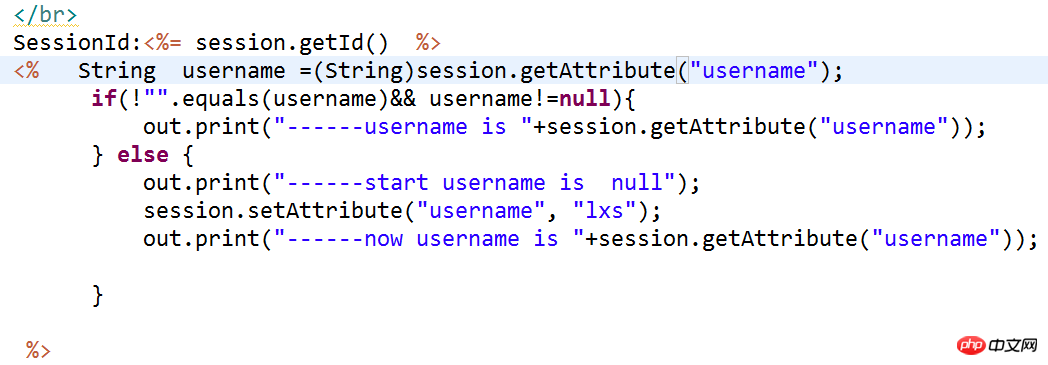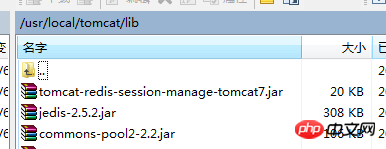Use redis to implement session sharing under tomcat cluster
The previous article implemented the TOMCAT cluster under the NGINX reverse proxy in LINUX()
This time we implemented it based on the previous article Session sharing problem
Nginx machine: 192.168.1.108
The two tomcat machines are: 192.168.1.168
192.168.1.178
1: Test session sharing issue
Add in the original index.jsp page The following code
SessionId:<%= session.getId() %>
<% String username =(String)session.getAttribute("username" );
if(!"".equals(username)&& username!=null){
out.print("------username is "+session.getAttribute("username"));
} else {
out.print("------start username is null");
session.setAttribute("username", "lxs");
out.print( "------now username is "+session.getAttribute("username"));
}
%>

At this time, the first time you visit through nginx is the 178 machine

When refreshing again, I accessed the 168 machine

##Okay It can be seen that the session is not shared at this time. Sessions are created separately under the cluster
2: Use redis to implement session sharing
There are many ways to achieve session sharing. This time, the session is stored in redis to achieve sharing.
1. Install redis (Please see how to install)
redis is also installed at 192.168.1.108, like Nginx Installed on the same machine
2. Copy the required jar packages to the lib directories of the two tomcats

3. Modify the contents in context.xml
respectively in tomcat/conf Add the following content to /context.xml
## host="192.168.1.108" port="6379" database="0" maxInactiveInterval="60" /> host is the host name of redis and port is redis The port database is the database in which the session is stored in redis.
4. Test session sharing again After the first three steps, the session sharing problem under redis has been realized, test again Start redis, nginx, and tomcat respectively and visit http://192.168.1.108:7777/nginxTest/ At this time nginx first forwards to 178 On that machine, at this time, the username in the session is empty, and then a value is stored in username, and then the value Visit http://192.168.1.108:7777/nginxTest/ again, at this time nginx is transferred to the machine 168 At this time the sessionid is the same as 178. At the same time, username also has a value, and the value is directly printed out. This shows that the session is shared at this time, and at the same time The corresponding session is also stored in redis. The above is the detailed content of Use redis to implement session sharing under tomcat cluster. For more information, please follow other related articles on the PHP Chinese website!




Hot AI Tools

Undresser.AI Undress
AI-powered app for creating realistic nude photos

AI Clothes Remover
Online AI tool for removing clothes from photos.

Undress AI Tool
Undress images for free

Clothoff.io
AI clothes remover

Video Face Swap
Swap faces in any video effortlessly with our completely free AI face swap tool!

Hot Article

Hot Tools

Notepad++7.3.1
Easy-to-use and free code editor

SublimeText3 Chinese version
Chinese version, very easy to use

Zend Studio 13.0.1
Powerful PHP integrated development environment

Dreamweaver CS6
Visual web development tools

SublimeText3 Mac version
God-level code editing software (SublimeText3)

Hot Topics
 1664
1664
 14
14
 1421
1421
 52
52
 1315
1315
 25
25
 1266
1266
 29
29
 1239
1239
 24
24
 How to build the redis cluster mode
Apr 10, 2025 pm 10:15 PM
How to build the redis cluster mode
Apr 10, 2025 pm 10:15 PM
Redis cluster mode deploys Redis instances to multiple servers through sharding, improving scalability and availability. The construction steps are as follows: Create odd Redis instances with different ports; Create 3 sentinel instances, monitor Redis instances and failover; configure sentinel configuration files, add monitoring Redis instance information and failover settings; configure Redis instance configuration files, enable cluster mode and specify the cluster information file path; create nodes.conf file, containing information of each Redis instance; start the cluster, execute the create command to create a cluster and specify the number of replicas; log in to the cluster to execute the CLUSTER INFO command to verify the cluster status; make
 How to read redis queue
Apr 10, 2025 pm 10:12 PM
How to read redis queue
Apr 10, 2025 pm 10:12 PM
To read a queue from Redis, you need to get the queue name, read the elements using the LPOP command, and process the empty queue. The specific steps are as follows: Get the queue name: name it with the prefix of "queue:" such as "queue:my-queue". Use the LPOP command: Eject the element from the head of the queue and return its value, such as LPOP queue:my-queue. Processing empty queues: If the queue is empty, LPOP returns nil, and you can check whether the queue exists before reading the element.
 How to configure Lua script execution time in centos redis
Apr 14, 2025 pm 02:12 PM
How to configure Lua script execution time in centos redis
Apr 14, 2025 pm 02:12 PM
On CentOS systems, you can limit the execution time of Lua scripts by modifying Redis configuration files or using Redis commands to prevent malicious scripts from consuming too much resources. Method 1: Modify the Redis configuration file and locate the Redis configuration file: The Redis configuration file is usually located in /etc/redis/redis.conf. Edit configuration file: Open the configuration file using a text editor (such as vi or nano): sudovi/etc/redis/redis.conf Set the Lua script execution time limit: Add or modify the following lines in the configuration file to set the maximum execution time of the Lua script (unit: milliseconds)
 How to use the redis command line
Apr 10, 2025 pm 10:18 PM
How to use the redis command line
Apr 10, 2025 pm 10:18 PM
Use the Redis command line tool (redis-cli) to manage and operate Redis through the following steps: Connect to the server, specify the address and port. Send commands to the server using the command name and parameters. Use the HELP command to view help information for a specific command. Use the QUIT command to exit the command line tool.
 How to implement redis counter
Apr 10, 2025 pm 10:21 PM
How to implement redis counter
Apr 10, 2025 pm 10:21 PM
Redis counter is a mechanism that uses Redis key-value pair storage to implement counting operations, including the following steps: creating counter keys, increasing counts, decreasing counts, resetting counts, and obtaining counts. The advantages of Redis counters include fast speed, high concurrency, durability and simplicity and ease of use. It can be used in scenarios such as user access counting, real-time metric tracking, game scores and rankings, and order processing counting.
 How to optimize the performance of debian readdir
Apr 13, 2025 am 08:48 AM
How to optimize the performance of debian readdir
Apr 13, 2025 am 08:48 AM
In Debian systems, readdir system calls are used to read directory contents. If its performance is not good, try the following optimization strategy: Simplify the number of directory files: Split large directories into multiple small directories as much as possible, reducing the number of items processed per readdir call. Enable directory content caching: build a cache mechanism, update the cache regularly or when directory content changes, and reduce frequent calls to readdir. Memory caches (such as Memcached or Redis) or local caches (such as files or databases) can be considered. Adopt efficient data structure: If you implement directory traversal by yourself, select more efficient data structures (such as hash tables instead of linear search) to store and access directory information
 How to locate memory leaks in Tomcat logs
Apr 13, 2025 am 08:18 AM
How to locate memory leaks in Tomcat logs
Apr 13, 2025 am 08:18 AM
This article introduces how to troubleshoot memory leaks through Tomcat logs and related tools. 1. Memory monitoring and heap dump First, use tools such as JVisualVM or jstat to monitor Tomcat's memory usage in real time, observe the changes in the heap memory, and determine whether there is a memory leak. Once a leak is suspected, use the jmap command to generate a heap dump file (heap.bin): jmap-dump:format=b,file=heap.bin, which is the Tomcat process ID. 2. Heap dump file analysis Use EclipseMemoryAnalyzerTool (MAT) or other tools to open the heap.bin file and analyze the memory.
 How to use the Redis cache solution to efficiently realize the requirements of product ranking list?
Apr 19, 2025 pm 11:36 PM
How to use the Redis cache solution to efficiently realize the requirements of product ranking list?
Apr 19, 2025 pm 11:36 PM
How does the Redis caching solution realize the requirements of product ranking list? During the development process, we often need to deal with the requirements of rankings, such as displaying a...




